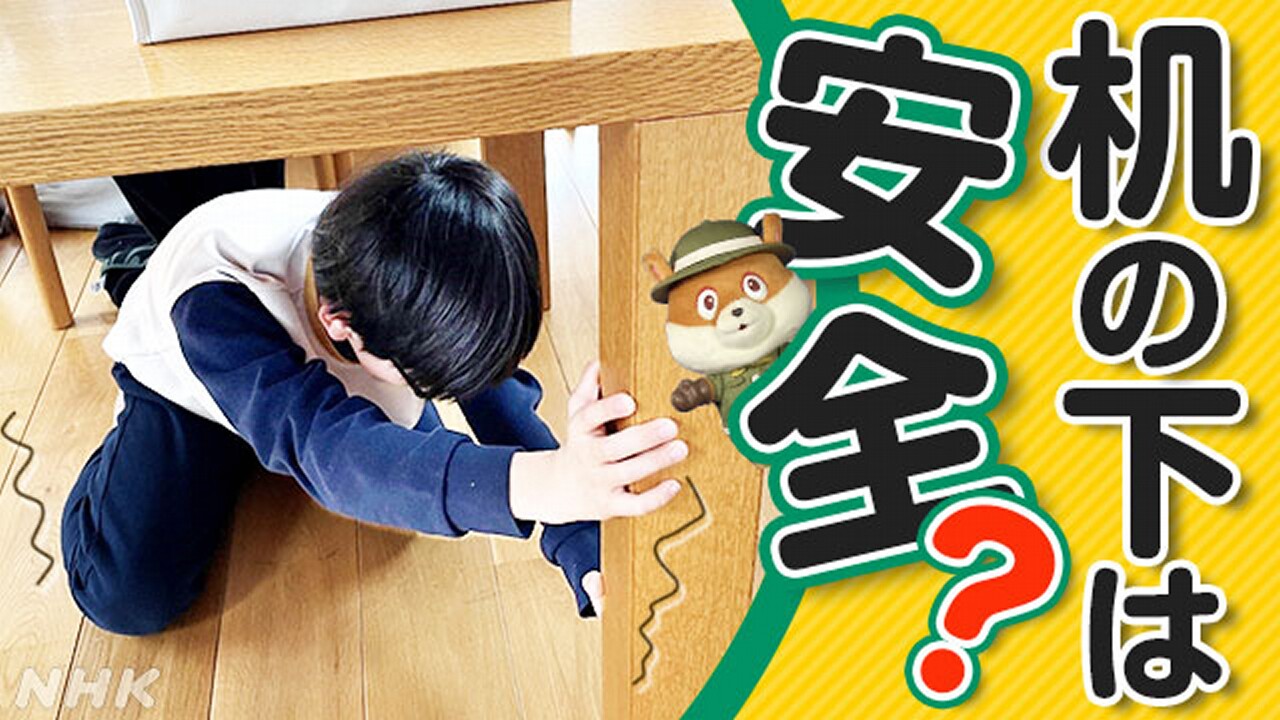"Earthquake early warning" at home! Where do children go? Is this common sense correct? March 8th, 8:22 am
During the Noto Peninsula Earthquake, many people were at home when they were struck by the tremors.
At school, we do evacuation drills to prepare for earthquakes, but the drills don't necessarily apply at home!
I, New Star (10 years old) from the "Children's News" expedition team, interviewed a disaster prevention expert!
(Broadcast on “News LIVE! Yu 5:00” on February 29th)
Is it really safe under the desk?
This is the person I heard the story from.
This is Takehiko Yamamura, director of the Disaster Prevention Systems Research Institute.
(Mr. Yamamura)
``It's sudden, but here's a quiz. An ``Earthquake Early Warning'' has just gone off.
Or I felt a small tremor.
What do you do?
”
What is an earthquake early warning?
Japan Meteorological Agency/Children's Leaflet
Get under the desk without hesitation!
(Mr. Yamamura)
``I'm not mistaken, but if there is glass such as a window right next to the desk, it is not absolutely safe under the desk.''
surely!
If there is glass nearby, it might be dangerous if it breaks.
So what should I do?
(Mr. Yamamura)
"It may take anywhere from a few seconds to more than ten seconds after the Earthquake Early Warning sounds for a major tremor to occur. During that time, get to the safest place possible."
Where is the safe place in the house?
Turn your “entrance” into a safe zone
One of the places Mr. Yamamura recommends is the entrance.
This is because there are relatively few things and it is easy to escape in an emergency.
To prevent the door from becoming distorted and unable to open, it's a good idea to leave the door open and use an ``inner lock'' instead of a handrail.
In order to make the entrance a safe place, it is important to leave as few things as possible!
It seems to be a good idea to put ``shatterproof film'' on the windows to prevent the glass from shattering.
Take action to save lives on the spot
But, if you don't have time to get to the front door, you don't have to force yourself to move.
Try to choose a safe place where furniture and other items will not tip over or fall.
According to Yamamura, it is important to make decisions on the spot and take actions to protect your own life.
Protect your neck with “Pillbug pose”
Next is the children's room on the second floor.
Even if an earthquake happens here, should I go to the front door?
(Mr. Yamamura)
"It's difficult, isn't it? In such cases, don't rush down to the first floor. The building is generally safer if you stay on the second floor."
The pill bug pose is recommended to protect yourself in the event of a sudden earthquake.
Important blood vessels run through your neck, so it's a good idea to protect it with your hands or a pillow.
If an earthquake suddenly occurs, you'll get panicked, so it's a good idea to practice this pose on a regular basis so you can do it quickly!
Luminous tape in case of night power outage
If an earthquake occurs at night, one thing you have to be careful about is power outages.
It's true that it's dangerous when it gets dark!
In such cases, a tape called ``luminescent tape'' that glows in the dark comes in handy.
If you put this tape on a doorknob, you'll know where the door is even in the dark.
The ways to protect yourself will vary depending on the time and place of the earthquake, so you need to think of various patterns in advance.
For communication, please use a public telephone.
How to keep in touch with your family after an earthquake is also important!
For that reason, you should remember to use a ``public phone''.
Mr. Yamamura, why is it a public phone?
(Mr. Yamamura)
``During a disaster, it is difficult to connect to mobile phones and landlines, but public phones allow you to make calls with priority.'' (*Before others)
That's right!
But how can I contact you using a public phone?
(Mr. Yamamura) ``
Inside the disaster-stricken area, telephone lines are congested and it becomes difficult to connect.However, calls from within the disaster-stricken area to outside the disaster-stricken area are relatively difficult. It's easy to communicate. If you have relatives or friends far away, leave a message with them to let them know if they're safe."
Notify using the disaster message dial
Does everyone know about the "Disaster Message Dial"?
This is a service that allows you to leave a message for 30 seconds by dialing 171 and following the voice guidance in the event of a disaster.
You can try it out for free on the 1st and 15th of every month.
(*Free trials are also available from January 1st to January 3rd, ``Disaster Prevention and Volunteer Week'' (January 15th to January 21st), and ``Disaster Prevention Week'' (August 30th to September 5th) )
Click here to learn how to use the “Disaster Message Dial”
I'm going to try it out right away!
"This is New Star. I'm in Shibuya right now! I'm not hurt!"
You only have 30 seconds, so it's a good idea to briefly tell them your name, where you are, and whether you're safe.
Everyone, please talk with the people around you about what you would do if an earthquake were to occur while you are at home.
New again!
Here's a review quiz.
Please try the challenge!
Watch the video here
NHK for School “What you want to know about earthquakes now”
We have compiled information about earthquakes that you should know.

